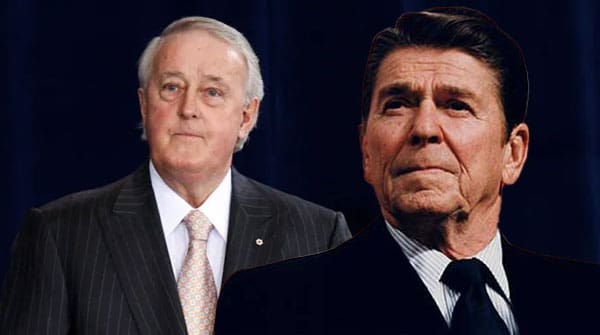The enduring friendship between Mulroney and Reagan shaped North American conservatism
 Brian Mulroney, Canada’s 18th Prime Minister, passed away on Feb. 29 at age 84. He had a remarkable life and career, rising from a humble blue-collar background in Baie-Comeau, Quebec, to winning two consecutive majority governments and leading our country for nearly nine years.
Brian Mulroney, Canada’s 18th Prime Minister, passed away on Feb. 29 at age 84. He had a remarkable life and career, rising from a humble blue-collar background in Baie-Comeau, Quebec, to winning two consecutive majority governments and leading our country for nearly nine years.
Many Canadian politicians, commentators and columnists (including me) have discussed various aspects of Mulroney’s life and career. It’s worth mentioning one final time that his fascinating story occurred at roughly the same time as the late, great Ronald Reagan’s.
Mulroney was first elected on Sept. 4, 1984, with the second-largest majority in Canadian political history. Reagan, the former Hollywood actor who had previously served as Governor of California (1967-1975), was in the latter stages of his successful U.S. presidential re-election campaign.
Although there were differences between the two world leaders – Reagan was 28 years older, while Mulroney was fluently bilingual – they had some surprising similarities.
 Brian Mulroney and Ronald Reagan |
| Related Stories |
| Brian Mulroney’s enduring battle against antisemitism
|
| Ted Byfield played an influential role in Canadian conservatism
|
| Killing NAFTA could save Canada’s economy
|
The two men came from Irish working-class backgrounds. They had risen to the upper echelons of their respective professions: Mulroney as a labour lawyer and Reagan as president of the Screen Actors Guild. They were both men of faith and tradition. They fell in love with beautiful, intelligent women (Mila Mulroney and Nancy Reagan) and “married up,” as Reagan once famously remarked. They were engaging individuals and brilliant orators. They were strong opponents of racism, antisemitism and injustice. They fought for the rights and personal liberties of Americans and Canadians. They understood that the art of politics involved (or used to involve) good ideas, strong policies, developing a firm base of supporters and building bridges with opponents and critics.
Of interest, neither of them started off in politically conservative circles of interest. Reagan was a staunchly anti-Communist Democrat who gradually shifted to the Republican Party. Mulroney grew up in a Quebec-based family of Liberal supporters and was encouraged to join the Progressive Conservatives by his longtime friend Lowell Murray when they attended university together.
“Mulroney and Reagan also shared similar personality traits,” Dr. Donald E. Abelson wrote in 2022 for the Brian Mulroney Institute of Government at St. Francis Xavier University. “They were incredibly effective communicators, possessed great empathy, were charismatic, exuded confidence, and had the capacity and willingness to build and mend fences. They could, and often did, reveal their displeasure with political foes, yet their first instinct was not to raise the ire of adversaries but to facilitate political co-operation. If this proved impossible, both had the capacity and inclination to rely on hard and soft power strategies to achieve desirable political outcomes.”
These two sons of Irish working-class families, who found their way into public life, became powerful politicians and built a conservative vision for North America. They also forged a lifelong political relationship and personal friendship.
One of their most well-known meetings was the Shamrock Summit between March 17 and 18, 1985. It appropriately started on St. Patrick’s Day and involved them singing “When Irish Eyes Are Smiling” with their wives. It was at this summit that Mulroney worked hard to achieve his important goal of building a stronger political and economic relationship between Canada and the U.S. Although Reagan and then-Prime Minister Pierre Trudeau reportedly had a good first meeting in 1981, their relationship became very icy over the next few years due to political and ideological differences. A thawing-out period between the two countries was desperately needed – and, with the luck of the Irish, that’s precisely what happened.
Mulroney and Reagan would be strong allies in the fight against Communism. They were powerful defenders of democracy, liberty and freedom in every corner of the world. These two men, along with British Prime Minister Margaret Thatcher and German Chancellor Helmut Kohl, would become the most visible faces of capitalism, free markets and liberal democratic societies.
They would also work on several important pieces of legislation that would transform the relationship between our two countries. The Canada-U.S. Free Trade Agreement, for instance, was an economic cornerstone for North America. It created a new era of trade liberalization and phased out many long-standing trade barriers, tariffs and restrictions. The success of this agreement ultimately led to the North American Free Trade Agreement (1994) and the United States–Mexico–Canada Agreement (2020). The two leaders also negotiated the Air Quality Agreement to find a solution to the problem of acid rain and control the escalating amounts of air pollutants. Mulroney and Reagan’s successor, George H.W. Bush, would sign the agreement in 1991.
Mulroney and Reagan’s friendship continued long after both men had left public life. When Mulroney spoke at Reagan’s funeral in June 2004, he famously called him “the leader we respected, the neighbour we admired and the friend we loved … Ronald Reagan was a president who inspired his nation and transformed the world.”
Two decades later, Ronnie and Brian are together again. The Irish eyes are smiling once more, and we’re smiling right back at them. Requiescat in pace, gentlemen.
Michael Taube, a Troy Media syndicated columnist and Washington Times contributor, was a speechwriter for former Prime Minister Stephen Harper. He holds a master’s degree in comparative politics from the London School of Economics.
For interview requests, click here.
The opinions expressed by our columnists and contributors are theirs alone and do not inherently or expressly reflect the views of our publication.
© Troy Media
Troy Media is an editorial content provider to media outlets and its own hosted community news outlets across Canada.

